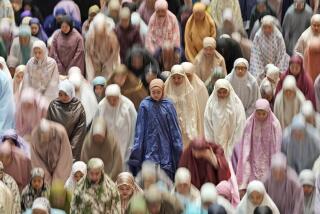Airports in Scramble to Add Security
As the nation prepares to mark the first anniversary of the Sept. 11 terrorist attacks, California airports are scrambling to complete dramatic structural changes to meet federal security mandates by the end of the year.
Most noticeable for passengers is likely to be a move by airports to add lanes and additional equipment at security checkpoints. Truck-sized explosives-detection machines also will start showing up in some airport lobbies and on the curbs, squeezing check-in lines for skycaps and at ticket counters.
Aging facilities such as Los Angeles International Airport will undergo extensive remodeling, as will several smaller, regional facilities, where officials are finding room for bulky new security equipment underground or in parking garages.
At LAX, subcontractors for Lockheed--the company contracted by the federal Transportation Security Administration to help redesign airports--plan to start increasing by 25% the security checkpoint lanes in the airport’s nine terminals. The work may require the relocation of some concessions.
Requiring major revisions are Terminals 1, 3, 4, 6 and the Tom Bradley International Terminal. Officials emphasize these plans must be cleared by the Transportation Security Administration.
Redesigned checkpoints are crucial not only to curb long lines, officials said, but to minimize security breaches, such as a July 27 incident in which a man ducked under a rope near a checkpoint in Terminal 5, forcing evacuation of the airport’s entire south side.
Contractors will widen checkpoints and install aisles with plexiglass walls on either side. Some passengers will be asked to step into these “wanding corrals,” where they will be examined with hand-held metal detectors.
“This will help decrease congestion at the X-rays because people can stand out of the way of other passengers to be ‘wanded’ behind a glass partition, where they can watch their carry-on bag as it goes through,” said Kim Day, deputy executive director of project and facilities development for the city agency that operates LAX.
New checkpoint areas also will feature improved signs alerting passengers to what is allowed on board, longer X-ray machine belts, tables set aside for hand searches of bags and special X-ray machines for passengers’ shoes.
San Francisco International Airport is widening security checkpoint lanes in its two domestic terminals, said airport spokesman Mike McCarron.
An additional screening lane will be built this fall at Ontario International Airport. Expanded checkpoints and lanes have been added at Long Beach and John Wayne airports.
At Hollywood-Burbank Airport, city building and safety inspectors halted efforts last month to begin construction on a 40,000-square-foot expansion of the main terminal to meet a federal Dec. 31 deadline that requires airports to screen all checked luggage for explosives.
The Burbank City Council will hear an appeal Sept. 17 of a decision by the city’s planning board to approve these design changes. The situation prompted airport directors to write the federal government to say they will be unable to meet the deadline, said Charles Lombardo, an airport authority commissioner.
To meet the Dec. 31 deadline, subcontractors for Boeing--the company contracted by the Transportation Security Administration to reconfigure airports to accommodate explosives-detection machines--will begin installing cables and other electrical equipment at LAX terminals in October.
The equipment will be used to operate several dozen explosives-detection machines, which generate three-dimensional images of objects inside closed bags, in airport lobbies and on some curbs. The new machines will require officials to reconfigure lines at ticket counters.
At San Francisco International and John Wayne airports, officials plan to install the truck-sized machines in systems used to move baggage. This configuration is more efficient than placing the machines in ticket lobbies, but costs more and is difficult to do at older facilities such as LAX.
At John Wayne, officials will spend $18 million to build two baggage systems that include about a dozen explosives-detection machines, said airport spokeswoman Ann McCarley. The hefty machines will require workers to build the systems in parking garages outside Terminals A and B, where they will eliminate some parking, she said.
LAX officials hope eventually to install explosives-detection machines in existing baggage systems, but that will take time, Day said. Starting this winter, most passengers’ checked luggage will be scanned with smaller trace-detection machines, she said.
LAX needs about 260 of these machines, which require workers to use a hand-held swab to detect explosive residue on the inside and outside of luggage, and must figure out where to install them in already overcrowded ticket lobbies, Day said.
There are still some unknowns about how new federal security rules, and the personnel hired to implement them, will affect the state’s airports.
“One of the bigger problems we’re having is finding square footage to house additional people,” said Sharon Diggs-Jackson, Long Beach Airport’s public affairs officer. “Our TSA agents need offices and, as they add people, they need a place to store their uniforms and effects.”
Federal screeners will begin moving into LAX security checkpoints in October, said David Stone, the Transportation Security Administration’s security director there.
Stone, who began work at LAX two months ago, is making other significant security changes, including deploying bomb-sniffing dogs more often on curbs and in airport parking garages, where they will check passengers’ luggage. “This will be part of our theme in the coming months,” Stone said. “We don’t want to be predictable or to allow people to say, ‘That’s how we’ve always done things in the past.’ ”
LAX may begin a two-week pilot program this month in conjunction with American Airlines and the Transportation Security Administration in Terminal 4, where it will eliminate gate screening by combining these checks at the main security checkpoint.
As part of this program--which is still under review--passengers whose boarding passes are flagged by the airline would go to a special lane at security checkpoints for a more thorough inspection instead of undergoing a second screening as they are about to board the airplane, Stone said.
He said his office will make a recommendation to the Transportation Security Administration about whether it should expand the program.
“We think this increases security by doing what used to be done at the gate more thoroughly at the main checkpoint,” Stone said. “It also reduces the hassle factor for our passengers, who often have duplicated checks at the gate.”
More to Read
Start your day right
Sign up for Essential California for news, features and recommendations from the L.A. Times and beyond in your inbox six days a week.
You may occasionally receive promotional content from the Los Angeles Times.






